[/caption]
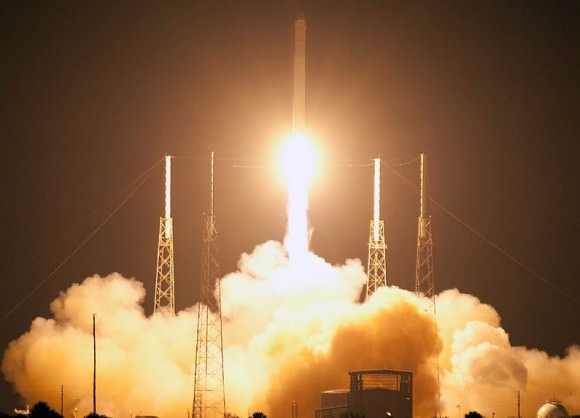
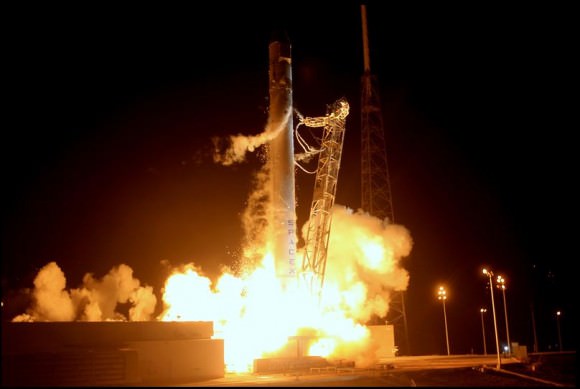
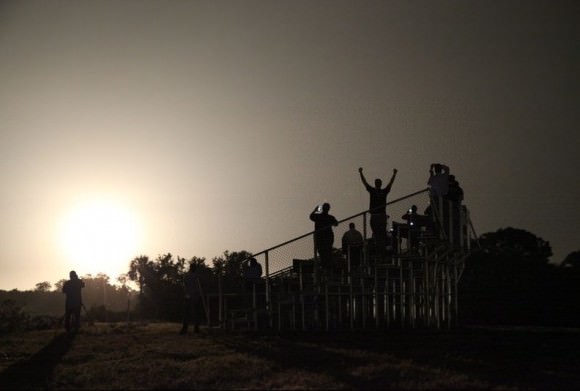

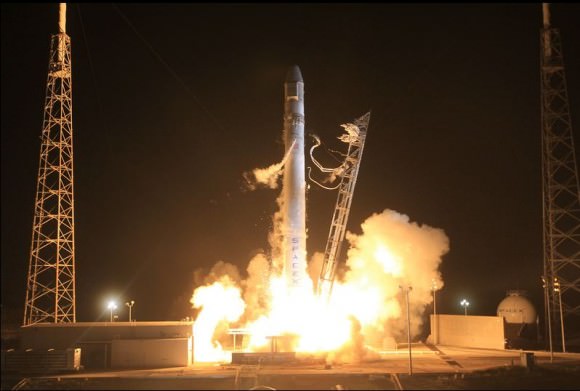
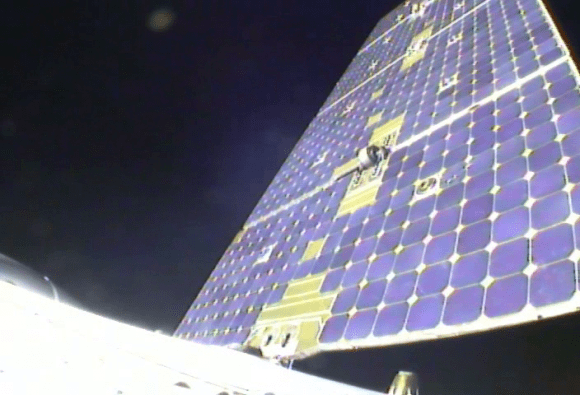
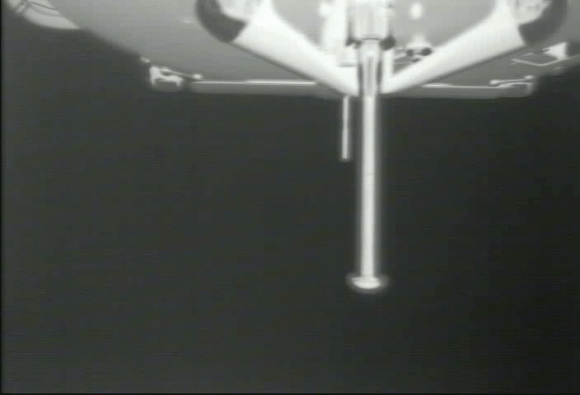
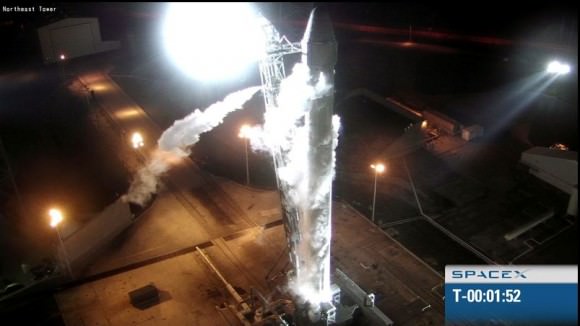
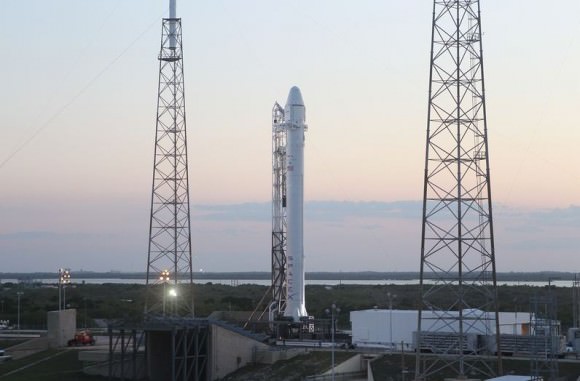
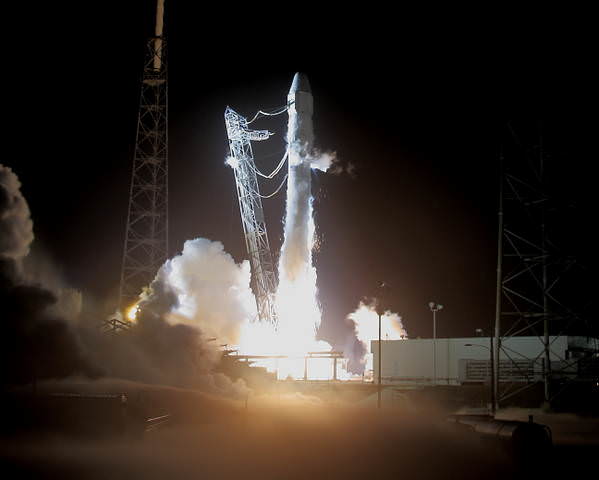
[/caption]









[/caption]
SpaceX has released this automated image, a first look inside the Dragon spacecraft in orbit after the successful launch early this morning. What is all on board the Dragon? The payload includes over 300 kilograms of food, crew clothing and pantry items, a NanoRacks Module of student experiments, and a laptop computer. On board the second stage, and not on board Dragon as reported earlier, was a canister from the Celestis company that included the cremated remains of more than 300 people, including Mercury astronaut Gordon “Gordo” Cooper and the actor James Doohan, famous for playing Scotty in the “Star Trek,” series.
You can see a pdf of the entire payload here, which also includes what Dragon will be taking back home from the ISS. This capability, being able to bring experiments, used parts and other items back to Earth, can currently only be done by the Soyuz spacecraft, and so this added capability that Dragon provides is a big.
What is next for Dragon? Here’s what will be happening the next few days:
May 23: Dragon orbits Earth as it travels toward the International Space Station.
May 24: Dragon’s sensors and flight systems are subjected to a series of complicated tests to determine if the vehicle is ready to berth with the space station; these tests include maneuvers and systems checks in which the vehicle comes within 1.5 miles of the station.
May 25: NASA decides if Dragon is allowed to attempt berthing with the station. If so, Dragon approaches. It is captured by station’s robotic arm and attached to the station, a feat that requires extreme precision.
May 25 – 31: Astronauts open Dragon’s hatch, unload supplies and fill Dragon with return cargo.
May 31: After approximately two weeks, Dragon is detached from the station and returns to Earth, landing in the Pacific, hundreds of miles west of Southern California.
Today, the big events (besides launch) included the successful deploy of the solar arrays, ensuring the capsule would have power to do all the on-orbit maneuvers and berthing to the ISS.
The next big event was the opening of the Guidance, Navigation and Control (GNC) door on the spacecraft, which allows Dragon to navigate in space with its Light Detection and Ranging, or LIDAR, and a star tracker GPS system. During the press conference this morning, SpaceX CEO Elon Musk referred to this as important as “opening the payload doors, much like in the movie 2001.”
If these videos don’t get your heart pumping or your eyes misting, I don’t know what will. Let’s all cheer along with SpaceX on their incredible accomplishment today! As has been said on Twitter, these are the people who really powered today’s launch.
More below:
Continue reading “Awesome Videos: Cheer Along with SpaceX Employees”
Do you believe in Dragons? In a spectacular night launch, SpaceX’s Falcon 9 rocket carrying the Dragon capsule is now heading for the first commercial rendezvous at the International Space Station. With an official launch time of 07:44:38 UTC/3:44:38 a.m. EDT, the Dragon capsule is now safely in orbit with its solar array wings deployed, and the mission begins for the COTS-2/3 cargo delivery demonstration mission.
“Falcon flew perfectly!! Dragon in orbit, comm locked and solar arrays active!! Feels like a giant weight just came off my back :),” Tweeted Elon Musk, SpaceX CEO.
“Today marks the beginning of a new era in exploration,” said NASA Administrator Charles Bolden, following the launch. “A private company has launched a spacecraft to the International Space Station that will attempt to dock there for the first time. And while there is a lot of work ahead to successfully complete this mission, we are certainly off to good start… This demonstrates the future of American space exploration, to have private industry provide for access to low Earth orbit while NASA goes off and does what it does best in exploring beyond in our solar system. It’s a great day for America, a great day for the world because there were people who thought that we were going away. We are not going away at all. The SpaceX/NASA team came through with flying colors.”
[/caption]
“The entire team at SpaceX and at NASA should be commended for their success on this third test flight of the Falcon 9 rocket,” said former astronaut Michael Lopez-Alegria, who is now the President of the Commercial Spaceflight Federation. “The preparations and precautions taken by SpaceX and NASA in months past have contributed to their exemplary performance today. After seeing the smooth launch SpaceX just executed, it is easy to forget that this is indeed rocket science.”
The Falcon 9 appeared to fly flawlessly, and after the crucial moment of solar array deploy, there were hugs and cheers all around in SpaceX’s mission control room.
The rendezvous at the ISS will happen on May 25, with the Canadarm2 grapple occurring at 12:06 GMT (8:06 a.m. EDT) on the 25th.
NASA has updated their Satellite Sightings page to include when the Dragon will be visible in the night skies.
The White House issued a statement from John Holdren, Assistant to the President for Science and Technology: “Congratulations to the teams at SpaceX and NASA for this morning’s successful launch of the Falcon 9 rocket from Cape Canaveral Air Force Station in Florida. Every launch into space is a thrilling event, but this one is especially exciting because it represents the potential of a new era in American spaceflight. Partnering with U.S. companies such as SpaceX to provide cargo and eventually crew service to the International Space Station is a cornerstone of the President’s plan for maintaining America’s leadership in space. This expanded role for the private sector will free up more of NASA’s resources to do what NASA does best — tackle the most demanding technological challenges in space, including those of human space flight beyond low Earth orbit. I could not be more proud of our NASA and SpaceX scientists and engineers, and I look forward to following this and many more missions like it.”
We’ll have more details and images from Ken Kremer and our group of photographers, live from Kennedy Space Center.
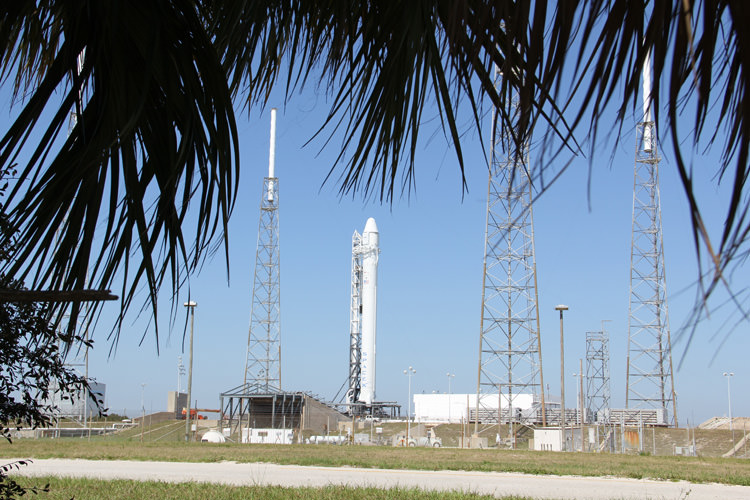
[/caption]
SpaceX engineers have successfully replaced a faulty valve in a first stage engine that triggered a launch abort on May 19 and that now clears the way for a second launch attempt of the firms Falcon 9 rocket and Dragon spacecraft in the overnight hours early on Tuesday, May 22.
Litfoff of the Falcon 9/Dragon duo on the first private rocket bound for the International Space Station (ISS) is slated for 3:44 AM on May 22 on the historic test flight mision dubbed COTS 2.
“We are ready for blastoff on May 22,” SpaceX spokeswoman Kirstin Grantham told Universe Today during an interview at Space Launch Complex-40 at Cape Canaveral, Florida earlier today as the Falcon 9 rocket was standing erect at the pad under a brilliant blue sky.
“The work to replace a faulty nitrogen engine valve is complete and took just a few hours,” Grantham confirmed to me.
After a thorough inspection of the vehicle and analysis of the repair, the SpaceX team cleared the rocket for launch. The rocket remained vertical during the repair work.
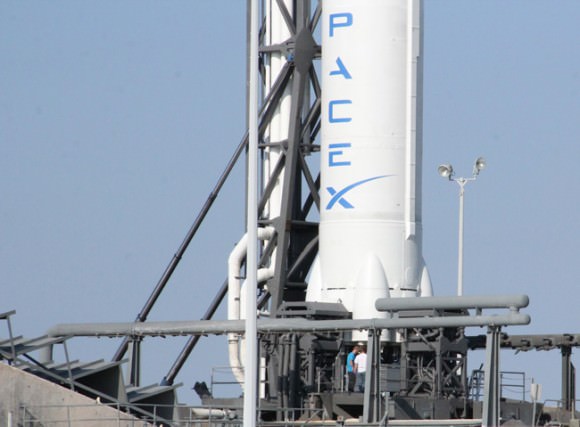
The weather forecast has improved markedly to an 80% chance of favorable conditions at launch time because the chance of rain showers has decreased. The primary concern is for cumulus clouds.
The launch will be broadcast live on NASA TV and via SpaceX Webcast at http://spacex.com
As on May 19, the launch window is instantaneous meaning SpaceX has just a fraction of a second to get the vehicle off the ground and there is no chance to recycle to a later launch time on the same day.
“The next possibility to launch after May 22 is on May 25,” said Grantham in the event of a scrub on Tuesday. “We could not reserve May 23 due to a conflict with Air Force requirements.”
The two stage Falcon 9 rocket is 157 feet tall. The first stage generates a million pounds of thrust from nine Merlin 1 C engines configured in a 3 by 3 by 3 arrangement.
The May 19 launch was aborted in a split second by the flight computer just 0.5 seconds before liftoff when they detected a slightly high pressure in the combustion chamber of engine number 5 located at the center of the first stage core.
If the launch proceeds as planned, the Dragon will separate from the Falcon 9 second stage some nine minutes after liftoff. Over the next two days, Dragon will close in on the ISS and then perform a series of complicated and stringent rendezvous and abort tests that bring the vehicle to within 1.5 miles and prove it can safely dock at the ISS and pull away in an emergency to prevent any chance of crashing into the ISS.
If NASA is satisfied with the test results, Dragon will be grappled with the robotic arm by US Astronaut Don Pettit and berthed at a port on the ISS on May 25. Astronauts would open the hatch on May 26 and begin unloading the nearly 1200 pounds of cargo consisting of non-critical items such as food, water, clothing and science experiments.
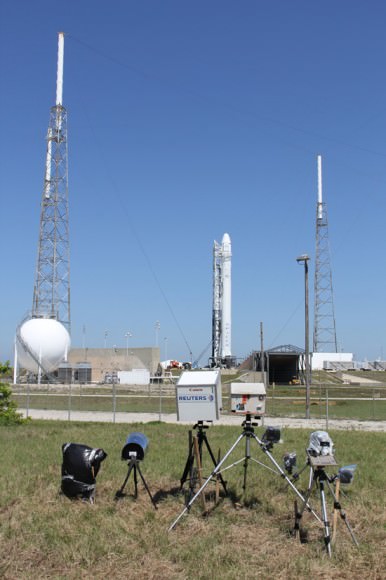
This is the first third test flight of the Falcon 9 rocket and the first test flight of the Dragon in this vastly upgraded configuration with solar panels.
Only four entities have ever sent a spacecraft to dock at the ISS – the United States, Russia, Japan and the European Union.
If successful, SpaceX will open a new era in spaceflight by giving birth to the first fully commercial mission to the orbiting space station complex and unlock vast new possibilities for its utilization in science and exploration.
SpaceX is under contract with NASA to conduct twelve Falcon 9/Dragon resupply missions to carry about 44,000 pounds of cargo to the ISS for a cost of some $1.6 Billion over the next few years.
The purpose of Dragon is to carry supplies to the ISS and partially replace the cargo capabilities of NASA’s now retired space shuttle. Dragon is a commercial spacecraft designed and developed by SpaceX that will eventually blast astronauts to space.
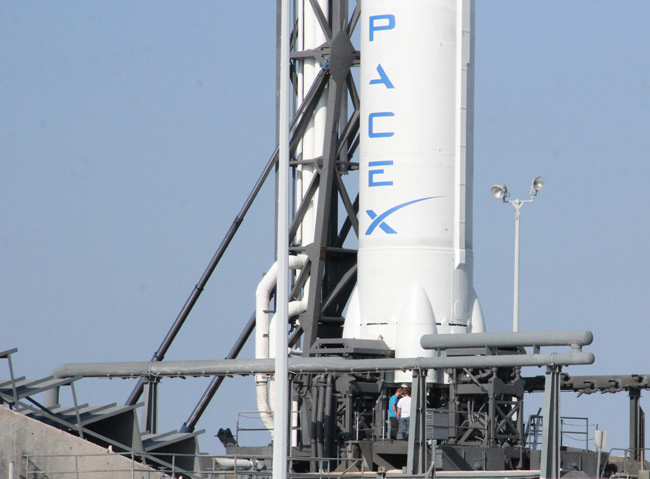
[/caption]
Today’s (May 19) historic launch of the first ever privately developed rocket bound for the International Space Station (ISS) was very surprisingly aborted at the last second when an engine glitch forced a dramatic shutdown of the Falcon 9 rockets 1st stage firing already in progress and as the NASA launch commentator was in the middle of announcing liftoff.
SpaceX and NASA are now targeting liftoff of the mission dubbed COTS 2, for Tuesday, May 22 at 3:44 AM EDT from Space Launch Complex-40 on Cape Canaveral Air Force Station in Florida. There is another launch opportunity on May 23.
Later today, SpaceX engineers determined that a faulty valve caused the engine abort failure. They are now in a race against time to complete all the repair work and mandatory assurance testing required in order to be ready to achieve the new May 22 launch date.
The Falcon 9 rocket was designed and developed by SpaceX and the first stage is powered by nine Merlin 1 C engines. As the countdown clock ticked down to T-minus zero, all nine engines ignited. But engine #5 suddenly developed a “high chamber pressure” and computers instantaneously ordered a shutdown of thrust generation by all nine engines just 0.5 seconds from liftoff and the rocket therefore never left the pad, said SpaceX President Gwynne Shotwell at a briefing for reporters.
“We’ve had a cutoff,” announced NASA launch commentator George Diller. “Liftoff did not occur. We’ve had a launch abort. Standing by.”
After draining the explosive propellants, SpaceX engineers began inspecting the engines later today within hours of the aborted liftoff to determine the cause of the rocket engine malfunction.
“This is not a failure,” Shotwell told reporters at a post scrub media briefing. “We aborted with purpose. It would have been a failure if we lifted off with an engine trending in this direction.”
SpaceX may have caught a lucky break by being able to fix the rocket at the pad instead of a time consuming engine changout. Shotwell said that one possibility was to roll the Falcon 9 rocket back into the processing hangar and swap out the engine with a new one.
This evening SpaceX announced they had determined the cause of the engine failure.
“Today’s launch was aborted when the flight computer detected slightly high pressure in the engine 5 combustion chamber, said SpaceX spokeswoman Kirstin Grantham. “We have discovered root cause and repairs are underway.”
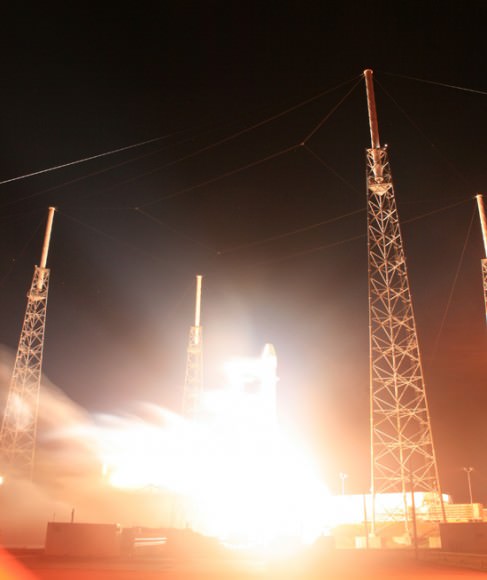
“During rigorous inspections of the engine, SpaceX engineers discovered a faulty check valve on the Merlin engine. We are now in the process of replacing the failed valve. Those repairs should be complete tonight. We will continue to review data on Sunday. If things look good, we will be ready to attempt to launch on Tuesday, May 22nd at 3:44 AM Eastern.”
The purpose of Dragon is to carry some 1200 pounds of supplies up to orbit and dock at the ISS and partially replace the capabilities of NASA’s now retired space shuttle.
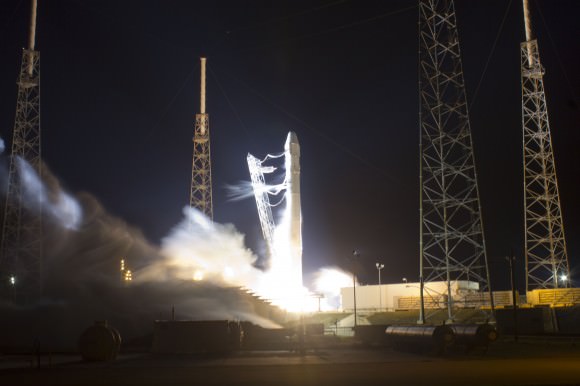
SpaceX is under contract with NASA to conduct twelve resupply missions to carry about 44,000 pounds of cargo to the ISS for a cost of some $1.6 Billion.
[/caption]
SpaceX’s attempt to launch their Falcon 9 rocket with the Dragon spacecraft was aborted by the computer at T-0 due to a high pressure reading on engine 5 of the first stage. The rocket’s nine main engines were ignited, but were automaticalaly shut down before liftoff. The vehicle was safed with no apparent other issues. SpaceX and NASA are now looking at the next launch window, which is on Tuesday, May 22 at 0744 UTC, 3:44 EDT. Computer checks all launch components just prior to launch, which is an extra safety feature of the Falcon 9, so the good part of the abort is knowing that all the systems worked as designed to prevent a liftoff that wasn’t within the designed parameters. Since this is a test flight, the SpaceX team likely thinks of this a successful launch abort as opposed to a failed launch.
See the video below:
“I have watched and participated in more scrubs of the shuttle than I would have liked, but it’s just part of the launch business,” said Michael Lopez-Alegria, former shuttle and ISS astronaut and President of the Commercial Space Federation. “I was extremely impressed with professionalism displayed by the SpaceX launch team in the moments after the scrub to safe the vehicle. We will have to wait for the team to perform the technical analysis of what caused the apparent high pressure in one of the engine’s combustion chambers and for SpaceX and NASA to decide when the next attempt will occur. This is not the outcome we were hoping for, but far better to detect and react to the problem while still in the pad than to have to deal with it in flight.”
When launched, Dragon will be the first commercial spacecraft to go to the International Space Station for cargo resupply.
We’ll have more details later, as SpaceX and NASA will have a press briefing later this morning.
[/caption]
Saturday morning’s launch window for SpaceX’s historic test flight to the International Space Station lasts just one second. Company President Gwynne Shotwell predicted they have “better than a 50-50 shot on whether we lift off tomorrow,” she said at a press conference today, adding, “If we lift off, we’ll get to orbit.”
Shotwell and NASA officials outlined a myriad of systems and activities that have to go perfectly for the launch take place, and then it will be non-stop action for the duration of the flight to orbit and ultimately the berthing of Dragon to the ISS.
Launch is set for 08:55 UTC on May 19 (4:55 AM Eastern/1:15 AM Pacific.) Here’s a timeline of activities so you can follow along while you watch the launch:
08:45 UTC: The Terminal Count begins at T-10 minutes before launch
08:52:30 (T-00:02:30) SpaceX Launch Director verifies GO
T-00:00:03 Engine controller commands engine ignition sequence to start
08:55: Liftoff
T+0:02:58 1st Stage Shut Down (Main Engine Cut Off)
T+0:03:02 1st Stage Separates
T+0:03:09 2nd Stage Engine Start
T+0:09:00 2nd Stage Engine Cutoff
09:04:34 (T+0:09:35) Dragon separates from Falcon 9 and initializes its propulsion system.
09:06:30 (T+0:11:30) Deploy solar array
09:08 (T+0:13) On-Orbit Operations begin
Shotwell said that 2 hours and 26 minutes into the flight is the Guidance Navigation and Control (GNC) door is opened on the exterior of the capsule. “This is a key new feature for this mission, which basically exposes the Proximity Operations Sensors to space so we can see the ISS as we are approaching and allow us to get close enough to berth,” Shotwell explained. “Our star trackers also get a view of space at this time, so this is a very critical operation”
The first 24 hours into the flight, Dragon will be catching up or phasing with the ISS. On Flight Day 2 at about 40 hours into the flight, Dragon will the ISS and do a “flyunder” of the station and for about 10 hours, do some maneuvers to demonstrate the ability to stationkeep and fly about the ISS, all the while in contact with the space station and Mission Control. There will be a relative GPS demonstration, and the “critical operations and tests we need to execute and show NASA the data so that we can show them everything is working,” Shotwell said.
Then, Dragon will perform a re-rendezvous with a flyunder of about 2.5 kilometers below the station, then maniever in front of the station, raise up and go back around.
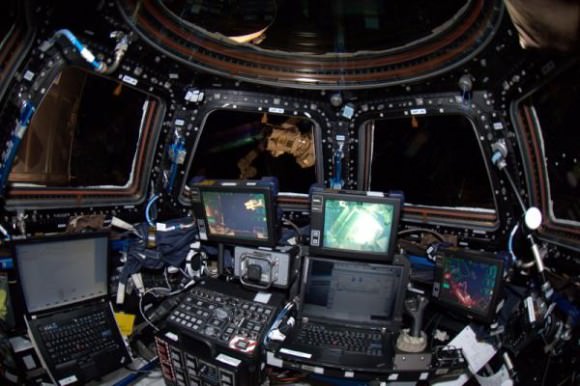
Don Pettit and Andre Kuipers will be working Canadarm2 on the station, and will grapple Dragon on May 22, berthing it to the Harmony node.
If there are any problems, NASA, SpaceX and the crew on the ISS has the ability to call an abort, or Dragon could autonomously abort.
But everyone is hoping for smooth sailing.
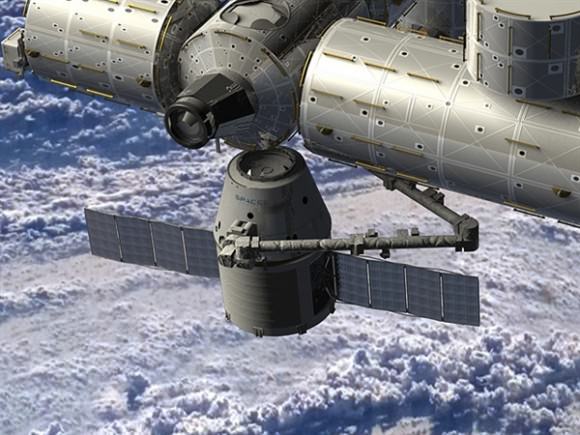
“By hour 75, if all is going well, we should be berthed to the station, which should be really great,” Shotwell said. “I know everyone at SpaceX is excited for this mission.”
The SpaceX launch webcast is scheduled for 1:15 AM Pacific / 4:15 AM Eastern / 08:15 UTC on May 19 at the SpaceX website, or you can watch on NASA TV starting at 08:30 UTC.
Right now the weather looks favorable for launch. If SpaceX can’t launch on the 19th, they can try again On May 22, 25th and 29th, which provide good launch opportunities. Other less than optimal dates for launch are the 23rd, 26th, and then the ISS enters into a period of high beta angle of the Sun, where there would be excessive heat surrounding the station, so the 29th of May is last date for awhile that SpaceX could launch Dragon.
Planetary Resources, Inc. has announced its plan to mine Near Earth Asteroids for their raw resources, ranging from water to precious metals like platinum. Using their Arkyd line of spacecraft, they will head to NEOs for exploration and extraction. One of the founders, Eric Anderson said they will launch their first spacecraft within 24 months, and eventually build ‘gas stations’ in space to enable deep space exploration.
The founders of this company say that resource extraction from asteroids will deliver multiple benefits to humanity and could be valued at billions of dollars annually. “The effort will tap into the high concentration of precious metals found on asteroids and provide a sustainable supply to the ever-growing population on Earth,” they said.
[/caption]
Last week a new company backed by a number of high-tech billionaires said they would be announcing a new space venture, and there was plenty of speculation of what the company –– called Planetary Resources — would be doing. Many ventured the company would be an asteroid mining outfit, and now, the company has revealed its purpose really is to focus on extracting precious resources such as metals and rare minerals from asteroids. “This innovative start-up will create a new industry and a new definition of ‘natural resources,’” the group said.
Is this pie in the sky or a solid investment plan?
It turns out this company has been in existence for about three years, working quietly in the background, assembling their plan.
The group includes X PRIZE CEO Peter Diamandis, Space Adventures founder Eric Anderson, Google executives K. Ram Shriram, Larry Page and Eric Schmidt, filmmaker James Cameron, former Microsoft chief software architect Charles Simonyi — a two-time visitor to the International Space Station — and Ross Perot Jr.
Even though their official press conference isn’t until later today, many of the founders started talking late yesterday. The group will initially focus on developing Earth orbiting telescopes to scan for the best asteroids, and later, create extremely low-cost robotic spacecraft for surveying missions.
A demonstration mission in orbit around Earth is expected to be launched within two years, according to the said company co-founders, and within five to 10 years, they hope to go from selling observation platforms in orbit to prospecting services, then travel to some of the thousands of asteroids that pass relatively close to Earth and extract their raw materials and bring them back to Earth.
But this company also plans to use the water found in asteroids to create orbiting fuel depots, which could be used by NASA and others for robotic and human space missions.
“We have a long view. We’re not expecting this company to be an overnight financial home run. This is going to take time,” Anderson said in an interview with Reuters.
President and Chief Engineer Chris Lewicki talked with Phil Plait yesterday and said “This is an attempt to make a permanent foothold in space. We’re going to enable this piece of human exploration and the settlement of space, and develop the resources that are out there.”
Lewicki was Flight Director for the NASA’s Spirit and Opportunity Mars rover missions, and also Mission Manager for the Mars Phoenix lander surface operations. He added that the plan structure is reminiscent of that of Apollo: have a big goal in mind, but make sure the steps along the way are practical.
Another of the aims of Planetary Resources is to open deep-space exploration to private industry, much like the $10 million Ansari X Prize competition, which Diamandis created. In previous talks, Diamandis has estimated that a small asteroid is worth about “20 trillion dollars in the platinum group metal marketplace.”
“The resources of Earth pale in comparison to the wealth of the solar system,” Eric Anderson told Wired.
The company will reveal more details in their press conference today (April 24) at 10:30 AM PDT | 12:30 PM CDT | 1:30 PM EDT | 5:30 UTC. You can watch at this link.
Sources: Bad Astronomy, Wired, Reuters